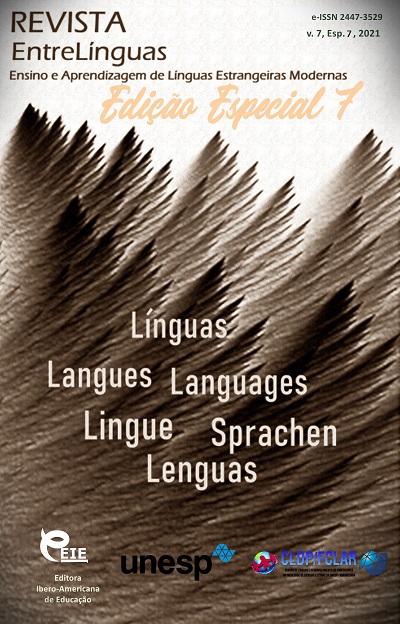Etymological features of the verbs of speaking
DOI:
https://doi.org/10.29051/el.v7iesp.7.16282Keywords:
Verbs, Verbs expressing thoughts, Semantics, Seme, Etymological analysis, Diachronic approachAbstract
The article deals with the etymological analysis of the verbs expressing thoughts (express, flourish, phrase, term, utter, vent, verbalize, vocalize, voice, word) in the perspective of semantics. The changes in the life of society are reflected in the semantic and word-forming structure of verbal formation. Verbs expressing thoughts could be no better able to describe the state of modern society, which in the last decades of the XXI century, the century of communication and information, is impossible to imagine without such concepts as interaction, communication, giving and receiving information, expressing ideas and thoughts. The verb is not enough to consider as a symbol of different processes, actions and states. It has the ability to “convert” the information about time, space, the idea of the subject, the object of the action and its tool. The activation of the situation occurs due to the metonymic and metaphorical transformations that underlie the nomination of the whole situation by the verb.
Downloads
References
APRESYAN, YU.D. Performances in grammar and in the dictionary. Selected works, 1995. Т.II. P. 199 -218. (in Russian)
Etymologishes Wörterbuch des Deutschen. Leit. W. Pfeifer. Berlin: Akademie-Verlag, 1989. Bd.1-3. 1662 S. (in German)
Latinsko-russkiy slovar (okolo 20000 slov.). Sost. A.M. Malinin. M.: Gos. Izdat. inostrannyih i natsionalnyih slovarey, 1952. 763 s. (in Russian)
LEONTIEV, A.A. Psycholinguistic units and the production of speech. M.: Science, 1969. 308 p. (in Russian)
SHMELYOV, D.N. Problems of semantic analysis of vocabulary. M., 1974. 279 p. (in Russian)
The Concise Oxford Dictionary of Current English. Edited by H.W. Fowler and F.G. Fowler. Oxford University Press, 1956. 1536 p.
The Oxford Dictionary of English Etymology. Edited by C.T. Onions. Oxford, 1966. 1026 p.
Downloads
Published
How to Cite
Issue
Section
License

This work is licensed under a Creative Commons Attribution-NonCommercial-ShareAlike 4.0 International License.
Os manuscritos aceitos e publicados são de propriedade da Revista EntreLínguas. Os artigos publicados e as referências citadas na Revista EntreLínguas são de inteira responsabilidade de seus autores.
Transferência de direitos autorais – autorização para publicação
Caso o artigo submetido seja aprovado para publicação, já fica acordado que o(s) autor(es) autoriza(m) a UNESP a reproduzi-lo e publicá-lo na EntreLínguas, entendendo-se os termos “reprodução” e “publicação” conforme definição respectivamente dos incisos VI e I do artigo 5° da Lei 9610/98. O artigo poderá ser acessado pela rede mundial de computadores (Internet), sendo permitidas, a título gratuito, a consulta e a reprodução de exemplar do artigo para uso próprio de quem a consulta, desde que haja a citação ao texto consultado. Essa autorização de publicação 328 EntreLínguas, Araraquara, v. 1, n .2, p. 323-328, jul./dez. 2015 não tem limitação de tempo, ficando a UNESP responsável pela manutenção da identificação do(s) autor(es) do artigo. Os artigos publicados e as referências citadas na Revista EntreLínguas são de inteira responsabilidade de seus autores.











